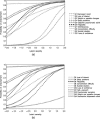Evaluation of the DSM-IV and ICD-10 criteria for depressive disorders in a community population in Japan using item response theory
- PMID: 20645305
- PMCID: PMC3671887
- DOI: 10.1002/mpr.320
Evaluation of the DSM-IV and ICD-10 criteria for depressive disorders in a community population in Japan using item response theory
Abstract
The DSM-IV and ICD-10 are both operational diagnostic systems that classify known psychological disorders according to the number of criteria symptoms. Certain discrepancies between the criteria exist and may lead to some inconsistencies in psychiatric research. The purpose of this study was to investigate these differences in the assessment of depression with item response theory (IRT) analyses. The World Mental Health-Japan (WMHJ) Survey is an epidemiological survey of the general population in Japan. We analyzed data from the WMHJ completed by 353 respondents who had either depressive mood or diminished interest. A two-parameter logistic model was used to evaluate the characteristics of the symptoms of the DSM-IV and ICD-10. IRT analyses revealed that the symptoms about psychomotor activity, worthlessness and self-reproach were more informative and suggestive of greater severity, while the symptoms about dietary habits were less informative. IRT analyses also revealed that the ICD-10 seems more sensitive to the mild range of the depression spectrum compared to the DSM-IV. Although there were some variations in severity among respondents, most of the respondents diagnosed with a severe or moderate depressive episode according to the ICD-10 were also diagnosed with a major depressive episode according to the DSM-IV.
Copyright © 2010 John Wiley & Sons, Ltd.
Figures



References
-
- American Psychiatric Association (1987) Diagnostic and Statistical Manual of Mental Disorders, 3rd edition‐revised, American Psychiatric Association.
-
- American Psychiatric Association (1994) Diagnostic and Statistical Manual of Mental Disorders, 4th Edition, American Psychiatric Association.
-
- Aggen S.H., Neale M.C., Kendler K.S. (2005) DSM criteria for major depression: evaluating symptom patterns using latent‐trait item response models. Psychological Medicine, 35, 475–487, DOI: 10.1017/S0033291704003563 - PubMed
-
- Boeck P.D., Wilson M. (2004) Explanatory Item Response Models: A Generalized Linear and Nonlinear Approach (3rd ed.), Springer.
-
- Cuijpers P., Smit F. (2002) Excess mortality in depression: a meta‐analysis of community studies. Journal of Affective Disorders, 72, 227–236, DOI: 10.1016/S0165‐0327(01)00413‐X - PubMed
Publication types
MeSH terms
Grants and funding
LinkOut - more resources
Full Text Sources

